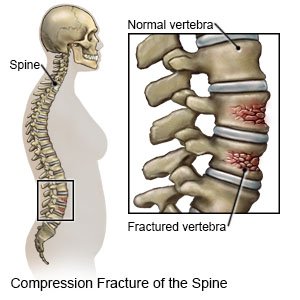Vertebral Compression Fracture
Medically reviewed by Drugs.com. Last updated on Apr 6, 2025.
AMBULATORY CARE:
A vertebral compression fracture (VCF)
is a collapse or breakdown in a bone in your spine. Compression fractures happen when there is too much pressure on the vertebra. VCFs most often occur in the thoracic (middle) and lumbar (lower) areas of your spine. Fractures may be mild to severe.
 |
Signs and symptoms:
You may not have any signs or symptoms with a mild VCF. You may have any of the following with a more severe fracture:
- Sudden, severe, and sharp back pain
- Back pain that gets worse when you stand or walk
- Muscle spasms in your back
- Problems urinating or having bowel movements
- Sudden weakness in your arms or legs
Call your local emergency number (911 in the US) if:
- You feel lightheaded, short of breath, and have chest pain.
- You cough up blood.
- You suddenly cannot feel your legs.
- You suddenly have trouble moving your arms or legs.
Seek care immediately if:
- Your arm or leg feels warm, tender, and painful. It may look swollen and red.
- You have new problems urinating or having bowel movements.
- You have severe pain in your back after falling, bending forward, sneezing, or coughing strongly.
Call your doctor or orthopedist if:
- You cannot sleep or rest because of back pain.
- You have pain or swelling in your back that is getting worse, or does not go away.
- You have questions or concerns about your condition or care.
Treatment
may include any of the following, depending on how severe the fracture is:
- Bed rest may be needed for a mild fracture.
- A back brace may be needed for 8 to 12 weeks. A brace may decrease your pain, and help your vertebrae heal.
- A cane or walker can help you keep your balance when you walk. This helps prevent a fall that could cause more injury.
- Medicines may be given for pain. Bisphosphonates and calcitonin are medicines to help your bones get stronger. They can decrease the pain of a VCF caused by osteoporosis, and decrease your risk for another fracture.
- Physical or occupational therapy may be recommended. A physical therapist teaches you exercises to help improve movement and strength, and to decrease pain. An occupational therapist teaches you skills to help with your daily activities.
- Surgery may be needed if your pain, weakness, or numbness does not go away with other treatment. Surgery may make your spine more stable, and help decrease pressure on your spinal nerves caused by the fracture.
Heat and ice:
- Apply ice on your back for 15 to 20 minutes every hour or as directed. Use an ice pack, or put crushed ice in a plastic bag. Cover it with a towel before you apply it. Ice helps prevent tissue damage and decreases swelling and pain.
- Apply heat on your back for 20 to 30 minutes every 2 hours for as many days as directed. Heat helps decrease pain and muscle spasms.
Activity:
- Avoid activities that may make the pain worse, such as picking up heavy objects. When the pain decreases, begin normal, slow movements as directed by your healthcare provider. Your healthcare provider may have you do weight-bearing exercises such as walking. You may also do non-weight-bearing exercises such as swimming and bicycling.
- You may need to use a walker or cane. Ask your healthcare provider for more information about how to use a cane or a walker.
- When you pick up objects, bend at the hips and knees. Never bend from the waist only. Use bent knees and your leg muscles as you lift the object. While you lift the object, keep it close to your chest. Try not to twist or lift anything above your waist.
Physical and occupational therapy:
Your healthcare provider may recommend you start or continue one or both types of therapy. A physical therapist teaches you exercises to help improve movement and strength, and to decrease pain. An occupational therapist teaches you skills to help with your daily activities.
Manage pain during sleep:
- Do not sleep on a waterbed. Waterbeds do not provide good back support.
- Sleep on a firm mattress. You may also put a ½ to 1-inch piece of plywood between the mattress and box spring.
- Sleep on your back with a pillow under your knees. This will decrease pressure on your back. You may also sleep on your side with 1 or both of your knees bent and a pillow between them. It may also be helpful to sleep on your stomach with a pillow under you at waist level.
Follow up with your doctor or orthopedist as directed:
You may need to return for x-rays or other tests. Write down your questions so you remember to ask them during your visits.
© Copyright Merative 2025 Information is for End User's use only and may not be sold, redistributed or otherwise used for commercial purposes.
The above information is an educational aid only. It is not intended as medical advice for individual conditions or treatments. Talk to your doctor, nurse or pharmacist before following any medical regimen to see if it is safe and effective for you.
Learn more about Vertebral Compression Fracture
Treatment options
Care guides
Symptoms and treatments
Medicine.com guides (external)
Further information
Always consult your healthcare provider to ensure the information displayed on this page applies to your personal circumstances.
